April 2024
Posted: 4/23/2024 3:25:27 PM
A study examining the feasibility of a 20-mile path for bicyclists and pedestrians connecting two of the largest bridges in the region is expected to be completed within the year.
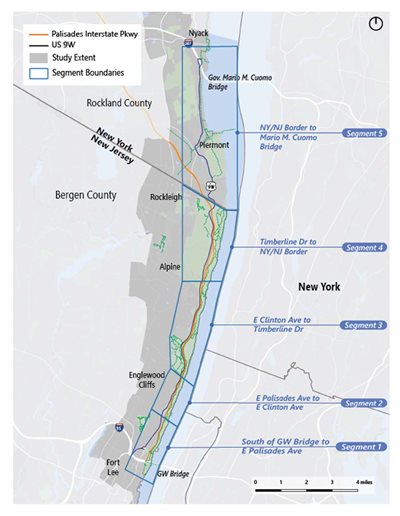 Lois Goldman, Director of Long Range Transportation Planning at the NJTPA, presented an update on the Palisades Shared Use Path Study to the NJTPA’s Project Prioritization and Planning and Economic Development committees during their April 15 joint meeting. The study led by the New York Metropolitan Transportation Council (NYMTC) is examining the potential for creating a path on the west side of the Hudson River between the Gov. Mario M. Cuomo Bridge, formerly the Tappan Zee, in Rockland County and the George Washington Bridge (GWB) in Fort Lee. NYMTC is the Metropolitan Planning Organization for New York City as well as Putnam, Rockland, and Westchester Counties. The NJTPA is assisting with the study.
Lois Goldman, Director of Long Range Transportation Planning at the NJTPA, presented an update on the Palisades Shared Use Path Study to the NJTPA’s Project Prioritization and Planning and Economic Development committees during their April 15 joint meeting. The study led by the New York Metropolitan Transportation Council (NYMTC) is examining the potential for creating a path on the west side of the Hudson River between the Gov. Mario M. Cuomo Bridge, formerly the Tappan Zee, in Rockland County and the George Washington Bridge (GWB) in Fort Lee. NYMTC is the Metropolitan Planning Organization for New York City as well as Putnam, Rockland, and Westchester Counties. The NJTPA is assisting with the study.
The impetus for the study was the renovation last year of the GWB pathway for bicyclists and pedestrians. There’s always been a lot of cyclists particularly on the west side of the Hudson, up Route 9W and into New York, Goldman said. The idea is to look at some potential alignments, particularly some of the physical and topographical challenges as it can be very steep along the Palisades.
The study area is divided into five distinct segments, four of which are in New Jersey:
- Fort Lee
- Englewood Cliffs
- Alpine Lookout
- Borough of Alpine
- Rockland County
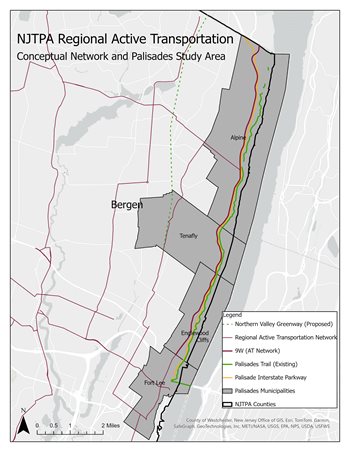
The study is looking at segments individually as well as together to come up with some options, Goldman said. The potential path is closely aligned with the NJTPA’s
Active Transportation Plan completed last June, which lays out a conceptual network of what a bicycle network would look like in the NJTPA’s 13-county region.
Three visioning workshops held virtually in March drew more attendance from residents of New York than New Jersey, according to Goldman. Bergen County serves on the study’s Advisory Committee and 14 towns along the route have been invited to serve on the committee. “We want to make sure communities in New York and in New Jersey are on board with this study," she said.
Union County Commissioner Bette Jane Kowalski, Vice Chair of the Planning and Economic Development Committee, asked if there would be separate paths for people walking and biking.
“It’s a shared use path but we don’t preclude anything at this point in terms of what that might be in the future; the objective is a shared use path," Gerry Bogacz, NYMTC’s Assistant Director of Planning and Program Management, said. “Safety is a big part of this, so clearly any type of separation between the modes is something we will look at, no question.”
A draft study report with findings and draft recommendations is expected by fall, when additional public meetings will be held. A final report is slated for completion by winter 2025. For additional information, visit
www.palisadespathstudy.com.
Posted: 4/22/2024 10:56:13 AM
After the bridge collapse in Baltimore, about 65 percent of the containers heading to that city’s port have been diverted to the Port of New York and New Jersey, which has the capacity to help handle that cargo as well as expected future growth.
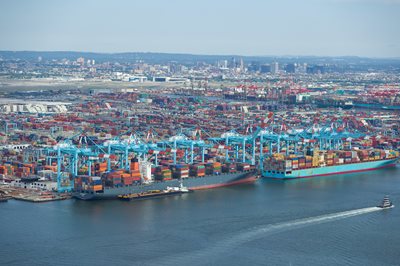 Those were among the insights offered in the annual port industry update at NJTPA’s Freight Initiatives Commitee (FIC) meeting on April 15. The presenters were Beth Rooney, Port Director for the Port Authority of New York and New Jersey, and John Nardi, President of the Shipping Association of New York and New Jersey.
Those were among the insights offered in the annual port industry update at NJTPA’s Freight Initiatives Commitee (FIC) meeting on April 15. The presenters were Beth Rooney, Port Director for the Port Authority of New York and New Jersey, and John Nardi, President of the Shipping Association of New York and New Jersey.
The Port of New York and New Jersey is the second busiest in the United States, in cargo volume. According to Rooney, that volume surged by 28 percent over 2019 levels during the pandemic, severely straining the port’s capacity. During the past year the growth has moderated to a level 4.4 percent higher than pre-pandemic volumes in 2019. Port traffic also includes 3.1 million metric tons of bulk cargo, more than 1 million cruise passengers, and 367,000 automobiles.
Response to Baltimore
In response to the Francis Scott Key Bridge collapse in Baltimore late last month, Port Newark added additional hours and Saturday gates to handle the increase in containers. There’s “more than enough capacity” at the port to address Baltimore’s needs, Rooney said, noting that the ships were already stopping in New Jersey, they’re just offloading more cargo here now.
To date, the port has issued credentials for about 450 Baltimore truckers now coming to its facilities to pick up cargo originally destined for Baltimore. Norfolk Southern and CSX also have added shuttle trains to move cargo between the ports.
The port is committed to receiving a third of the automobiles that otherwise would have gone to Baltimore, the nation’s largest port for processing cars and trucks. Many of the diverted vehicles are being trucked on car-carriers back to Baltimore for processing, helping sustain that port’s labor force, she said.
From Shortage to Surplus
“We’re in a very unusual situation for this port,” Nardi said, after the “volume pendulum” swung last year from record cargo volumes to a sharp decline. “We quickly went from daily [labor] shortages and a burned-out workforce to having a surplus of longshoremen,” he said, as many as 400 a day.
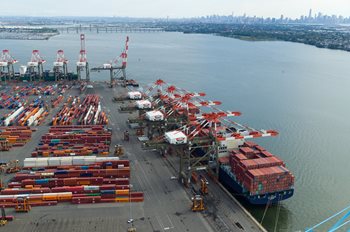 This year, the association has shifted focus to worker retention recognizing that its pool of trained and experienced workers cannot be easily replaced. It has turned to spending $10 to $15 million training all workers, whether actively working or not, on specialized machinery.
This year, the association has shifted focus to worker retention recognizing that its pool of trained and experienced workers cannot be easily replaced. It has turned to spending $10 to $15 million training all workers, whether actively working or not, on specialized machinery.
“It looks like ‘Star Wars’ with the type of machinery people are operating,” Nardi said. There were 825 new certifications for handling the equipment in 2023 and 2,130 recertifications. Almost 2,000 workers were trained or retrained. If normal growth occurs, Nardi suggested these workers should find a permanent home or sustainable income in a couple of years.
All the while his association, as part of the Council on Port Performance, is conducting outreach and working with area schools to secure workers for future labor needs at the port.
Lessons Learned
Asked whether there was a silver-lining for the freight industry going through the pandemic, Nardi said, “I feel like we graduated from the pandemic school. … We got a tremendous lesson in in what needs to change going forward.” This includes the need to find the right incentives to create 24/7 operations, which the industry has begun to pursue.
Rooney said during the surge of freight following the pandemic, the port was straining against its limits, handling volumes not expected until 2030. “But we handled it well and we didn't have the backups that you saw at other ports.” This gave increased confidence to shipping companies that the New York-New Jersey port can handle their needs, even in the face of disruptions and the need for new supply chains, she said.
A recording of the FIC meeting and the presentation slides are available here.
Posted: 4/11/2024 2:58:16 PM
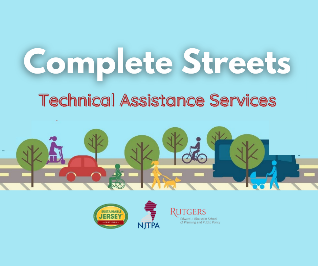 Five municipalities have been selected through a competitive application process to participate in the NJTPA’s Complete Streets Technical Assistance Program.
Five municipalities have been selected through a competitive application process to participate in the NJTPA’s Complete Streets Technical Assistance Program.
Belmar, Paterson, Readington and Verona will conduct complete street corridor assessments, while Belleville will develop a bicycle corridor plan. The program will assist the municipalities in documenting existing conditions, exploring potential improvements, and developing recommendations to make it safer for people walking and/or biking in the study areas. (See project summaries below).
“Complete Streets help make our roads safer for everyone, especially people walking and biking,” said NJTPA Chair John P. Kelly, an Ocean County Commissioner. “They also help create more equitable and healthy communities by giving people more options when travelling. This program helps municipalities advance their Complete Streets goals.”
The NJTPA funds this program and provides technical assistance in partnership with the Alan M. Voorhees Transportation Center at Rutgers University and Sustainable Jersey. The Complete Streets Technical Assistance Program helps municipalities bring together key stakeholders to explore a local safety concern and develop concepts for potential solutions using a collaborative approach.
“It is valuable for municipalities to receive hands-on guidance to move their Complete Streets projects forward. Complete and Green Streets have numerous safety, environmental, equity and health benefits,” said Randall Solomon, Executive Director of Sustainable Jersey. “This work is an important element in the comprehensive sustainability programs of our communities and contributes to our mission to create a more sustainable New Jersey."
Complete Streets balance the needs of drivers, pedestrians, bicyclists, transit riders, emergency responders, goods movement and stormwater management based on the local context. They help improve health and safety for people walking and biking and create better places to live, work, play, learn, and do business. When streets are not complete, the negative impacts on public health, safety, equity, the economy, and the environment are disproportionately borne by low-income and minority communities.
Improving safety is a key goal of this program.
“Across New Jersey and the broader nation, we’ve seen a troubling rise in roadway fatalities, particularly among pedestrians and cyclists,” said Jon A. Carnegie, Executive Director of the Alan M. Voorhees Transportation Center. “The recommendations that are developed through these projects will help communities enhance the safety of their roadways for all users,”
This is the fourth time the NJTPA has offered technical assistance to municipalities in its region. Learn more at njtpa.org/completestreets.
Summaries of the five selected projects are as follows:
Belleville Township — A bicycle corridor plan will primarily focus on Division Avenue from Union Avenue to Passaic Street, a wide road that experiences congestion, especially during school drop-off and pick-up. Vehicle speeding is also a concern in the area. This effort will explore the possibility of adding a bicycle lane to the corridor and is expected to include a pop-up demonstration to illustrate to community members what that could look like.
Belmar Borough — A Complete Streets corridor assessment will focus on a half-mile stretch of 8th Avenue from the beach to near Silver Lake. This busy road connects residents to important services and serves tourists during the busy summer season. This effort will explore ways to improve safety for all travelers, but especially those walking and biking.
Paterson City — A Complete Streets corridor assessment will focus on McBride Avenue from Paterson Great Falls National Historic Park at Wayne Avenue to the pedestrian bridge at Rockland Street. The assessment will explore ways to provide direct pedestrian access to Westside Park and improve pedestrian safety along the busy corridor.
Readington Township — A Complete Streets corridor assessment will focus on Main Street (County Route 523) from the Whitehouse Train Station to just south of Route 22. The study area is the most densely populated portion of the Township and experiences high vehicular traffic. With housing, the train station, the municipal building, and parks along the county road, many residents walk in this area. This assessment will explore ways to improve safety along this busy corridor.
Verona Township — A Complete Streets corridor assessment will focus on Linden Avenue from Fairview Avenue to Wildwood Terrace. This corridor is near several public schools as well as the Bloomfield Avenue town center. Pedestrians, cyclists, and motorists traverse Linden Avenue to access these various destinations. Speeding is a concern along Linden Avenue, particularly with the number of students using the road to walk to school. This assessment will explore ways to make the road safer, particularly for pedestrians and cyclists.